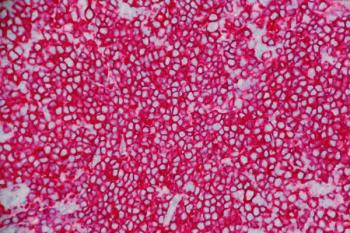
Overview of Nurtec ODT for Prevention of Episodic Migraine
Nurtec is the first oral calcitonin gene-related peptide antagonist approved for both acute and preventative treatment of migraine.
Rimegepant (Nurtec) was approved by the FDA on May 27, 2021, for preventative treatment of episodic migraine in adults. Episodic migraine is defined as headaches that occur fewer than 15 days per month.1 Nurtec is the first oral calcitonin gene-related peptide (CGRP) antagonist approved for both acute and preventative treatment of migraine.2-4
Migraine and CGRP
According to the National Institutes of Health, migraine-associated pain involves an intense pulsing or throbbing pain in one area of the head. It is often accompanied by nausea, vomiting, phonophobia, and/or photophobia.
Migraine is one of the leading neurological disorders and affects more than 10% of the population worldwide. Common migraine triggers include stress, anxiety, hormonal changes, weather changes, bright or flashing lights, lack of food or sleep, and dietary substances.5 Identification and avoidance of patient-specific triggers may reduce or prevent migraine attacks.
While the etiology of migraine remains less known, it is well established that CGRP—a highly potent vasodilatory protein—plays a pivotal role in its pathophysiology.6,7 During a migraine attack, activation of the trigeminal nerve results in neuropeptide release.
This causes neurogenic inflammation in the meningeal vasculature, which leads to mast cell degranulation, vasodilation, and activation of nociceptors. Due to knowledge regarding the role of CGRP in migraine pathophysiology, new medications specifically targeting CGRP or its receptor have been developed.
Unlike other therapies approved for migraine prevention, these agents target migraine-specific mechanisms without concern for vasoconstrictive effects.8,9 CGRP receptor antagonists are thought to alleviate migraines though the following processes:10
- Blocking neurogenic inflammation: CGRP receptor antagonists bind to CGRP receptors present on mast cells, which inhibits inflammation caused by the trigeminal nerve release of CGRP onto mast cells within the meninges of the brain.
- Decreasing artery dilation: CGRP receptor antagonists inhibit dilation of intracranial arteries by blocking CGRP receptors present in smooth muscle cells.
- Inhibiting pain transmission: CGRP receptor antagonists bind to CGRP receptors, which results in suppression of pain through inhibition of the central relay of pain signals.
Dosage and Administration11
Dosing of Nurtec is as follows:
- Migraine prevention: 75 mg by mouth every other day
- Acute treatment of moderate to severe migraine: 75 mg by mouth daily as needed
- Max: 1 tablet per 24 hours
- Dose adjustments (Adult)
- Altered kidney function
- CrCl ≥15 mL/min: no dose adjustment necessary
- CrCl <15 mL/min: avoid use
- Patients on dialysis: Avoid use
- Hepatic impairment
- Mild to moderate impairment: no dose adjustment necessary
- Severe impairment: Avoid use
- Altered kidney function
- Note: Up to 18 doses of Nurtec may be taken per month
Administration of Nurtec
Remove Nurtec from the blister pack immediately before use and place it on or under the tongue to dissolve—no additional liquid needed.
Efficacy of Nurtec for Prevention of Episodic Migraine12
Use of Nurtec 75 mg for the preventive treatment of episodic migraine was evaluated in a multi-center, double-blind, placebo-controlled, randomized clinical trial. Trial participants with ≥ 1-year history of migraine were randomized to receive every other day dosing of Nurtec 75 mg (n=373) or placebo (n=374) for 12 weeks.
Participants were allowed to remain on 1 medication with possible effects of migraine prevention if the dose was stable for a minimum of 3 months and was not expected to change during the course of the study.
- Primary endpoint: Change from baseline in the mean number of monthly migraine days (MMDs) during weeks 9-12.
Inclusion criteria:
- ≥18 years of age with ≥1-year history of migraine.
- Onset of migraine prior to 50 years of age.
- 4-18 moderate to severe migraine attacks per month within the previous 3 months prior to the initial screening visit.
- ≥6 migraine days during the observation period.
- ≤18 headache days (migraine or non-migraine) during the observation period.
- Ability to distinguish migraine attacks from tension/cluster headaches.
Individuals were excluded from trial participation if they had a history of basilar or hemiplegic migraine, were currently pregnant or breastfeeding, and/or had a history of any unstable medical conditions. Additionally, those who had been treated for (or showed evidence of) alcohol or drug abuse within the past 12 months and those who had an electrocardiogram or laboratory test finding that raised safety or tolerability concerns were not included in the trial.
Other criteria related to past medical history or comorbid conditions warranted study exclusion as further defined in the supplemental appendix. Nurtec 75 mg dosed every other day for prevention of episodic migraine demonstrated statistically significant improvements for the primary efficacy endpoint when compared to placebo, as outlined in Table 2.
Contraindications, Warnings, and Precautions4
The only known contraindication to Nurtec is hypersensitivity to the medication or any component of the formulation, which may present as dyspnea, rash, or delayed serious reactions. It is recommended to discontinue therapy if hypersensitivity occurs.
Disease-Related Concerns
Use of Nurtec is not recommended for patients with severe hepatic impairment or end-stage renal disease.
Appropriate Use
The safety of using >18 doses of Nurtec in a 30-day period has not been established.
Pregnancy and Breastfeeding Considerations
Nurtec use in women who are pregnant or breastfeeding is not recommended at this time due to lack of available evidence.
Important Counseling Points for Patients
Frequency of Use4
- Migraine prevention: 75 mg by mouth every other day
- Acute treatment of moderate to severe migraine: 75 mg by mouth daily as needed
- Max of 1 tablet per 24 hours
- Use of >18 tablets per 30-day period has not been established
Adverse Effects4
- Gastrointestinal: abdominal pain (≤ 2%), dyspepsia (≤ 2%), nausea (2-3%)
- Dermatologic: skin rash (<1%)
- Respiratory: dyspnea (<1%)
Expectations of Migraine Prevention Therapy13
- Success is defined as:
- 50% reduction in migraine attack frequency or days within 3 months
- Significant decrease in duration of migraine attack
- Improved response to acute medication
- Maximal response to treatment may take 2-6 months
Drug-Drug Interactions11
- CYP3A4 Inhibitors
- Nurtec use with strong CYP3A4 inhibitors is not recommended
- Avoid another dose of Nurtec within 48 hours when given with a moderate CYP3A4 inhibitor
- CYP3A4 Inducers
- Nurtec use with strong or moderate CYP3A4 inducers is not recommended
- Transporters
- Nurtec is a substrate of permeability glycoprotein (P-gp) and breast cancer resistance protein (BCRP) efflux transporters
- Use of Nurtec with P-gp and/or BCRP inhibitors is not recommended
Conclusion
Nurtec is the first oralCGRP antagonist approved for the prevention of episodic migraine. Additionally, it is the only medication currently approved for both acute and preventative treatment of migraine.
Patient-specific characteristics and comorbidities should be taken into consideration when selecting a medication regimen for management of migraines. When choosing to initiate Nurtec for prevention of episodic migraine, in-depth medication counseling and appropriate monitoring of an individual’s response to therapy should be implemented.
References
- Lipton RB, Silberstein SD. Episodic and chronic migraine headache: breaking down barriers to optimal treatment and prevention. Headache: The Journal of Head and Face Pain. 2015;55:103-122. doi:10.1111/head.12505_2.
- Drug Trials Snapshots: Nurtec® ODT. United States Food and Drug Administration.Updated online March 19, 2020. Accessed December 11, 2021.
https://www.fda.gov/drugs/development-approval-process-drugs/drug-trials-snapshots-nurtec-odt . - Nurtec® ODT (rimegepant). Biohaven Pharmaceuticals, Inc; 2021. Updated online April 30, 2021. Accessed December 3, 2021.
https://www.nurtec.com/?utm_source=google&utm_medium=cpc&utm_term=nurtec&gclid=CjwKCAjw2P-KBhByEiwADBYWCmvqwwyVVv7qbLSIziREwIReq7A5j6yQ76lI1tSj9obMvnhsqNiiOxoCsVQQAvD_BwE&gclsrc=aw.ds - Nurtec® ODT. In: Lexi-Drugs. Lexi-comp Online. Wolters Kluwer Health Inc. Updated September 30, 2021. Accessed December 11, 2021.
http://online.lexi.com - Migraine Information Page. National Institute of Neurological Disorders and Stroke. Updated online December 31, 2019. Accessed November 19, 2021.
https://www.ninds.nih.gov/Disorders/All-Disorders/Migraine-Information-Page - Edvinsson L. The Trigeminovascular Pathway: Role of CGRP and CGRP Receptors in Migraine. Headache: The Journal of Head and Face Pain. 2017;57:47-55. doi:10.1111/head.13081.
- Edvinsson L, Haanes KA, Warfvinge K, et al. CGRP as the target of new migraine therapies - successful translation from bench to clinic. Nature Reviews Neurology. 2018;14(6):338-350. Doi:10.1038/s41582-018-0003-1.
- Durham PL, Vause CV. Calcitonin gene-related peptide (CGRP) receptor antagonists in the treatment of migraine. CNS Drugs. 2010;24(7):539-548. doi:10.2165/11534920-000000000-00000.
- Ho TW, Edvinsson L, Goadsby PJ. CGRP and its receptors provide new insights into migrainepathophysiology. Nature Reviews Neurology. 2010;6(10):573-582. doi: 10.1038/nrneurol.2010.127.
- Durham PL. CGRP-receptor antagonists--a fresh approach to migraine therapy? New England Journal of Medicine. 2004;350(11):1073-1075. doi:10.1056/NEJMp048016.
- Nurtec® ODT. Prescribing Information. Biohaven Pharmaceuticals, Inc; 2021. Accessed December 5, 2021.
https://www.accessdata.fda.gov/drugsatfda_docs/label/2021/212728s006lbl.pdf . - Croop R, Lipton RB, Kudrow D, et al. Oral rimegepant for preventive treatment of migraine: a phase 2/3 randomised, double-blind, placebo-controlled trial. The Lancet. 2021;397(10268):51-60. doi: 10.1016/S0140-6736(20)32544-7.
- Silberstein SD. Preventive Migraine Treatment. Continuum: Lifelong Learning in Neurology. 2015;21:973-989. doi:10.1212/CON.0000000000000199.
Newsletter
Stay informed on drug updates, treatment guidelines, and pharmacy practice trends—subscribe to Pharmacy Times for weekly clinical insights.














































































































































































































